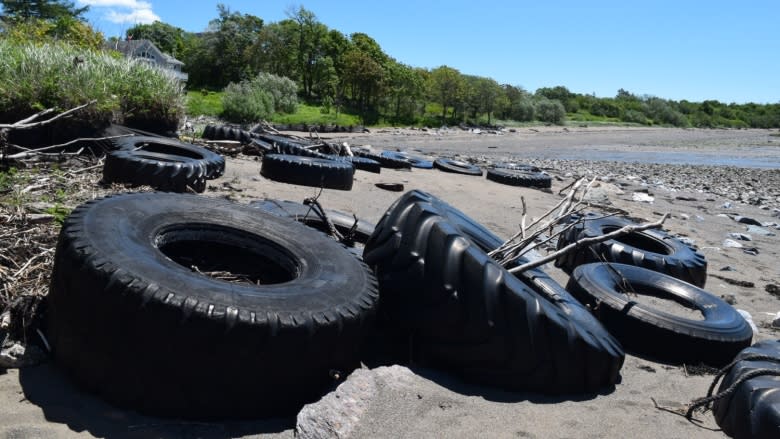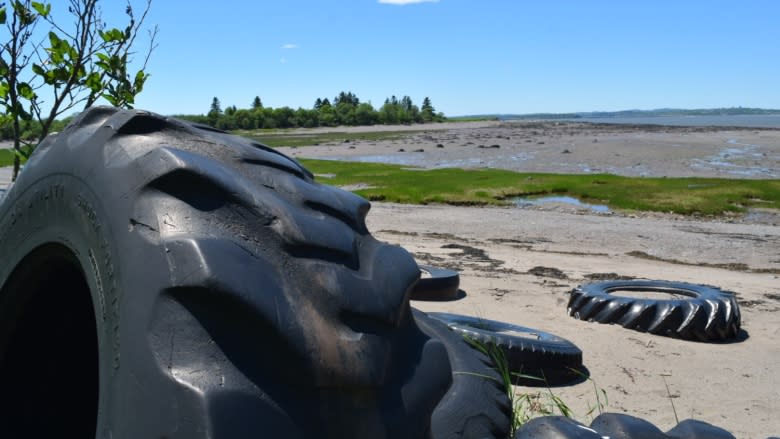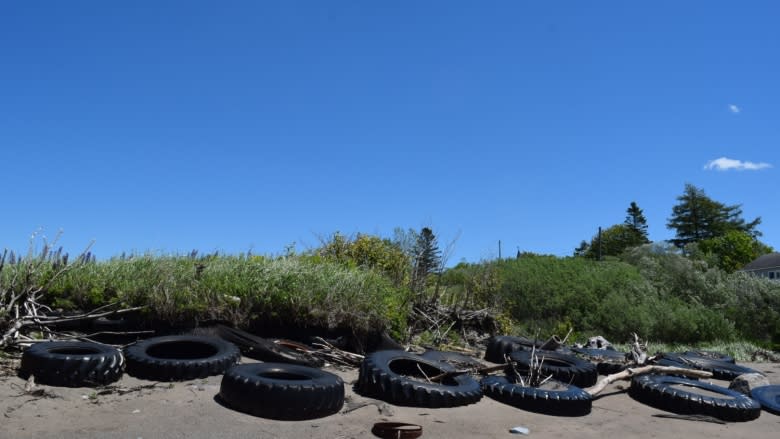Tire graveyard: how one group's attempt to save the land resulted in a rubber-filled burial ground
On the beach near Red Head Road in Saint John, it looks as though a container filled with monster truck wheels washed up on shore.
Beneath the sand there are hundreds more black tires hidden from the light.
The tires are the two-decade old remnants of a failed plan to save the environment. One that backfired in a big way and led to a beach littered with synthetic rubber and good intentions.
"Various landowners even to this day don't want the scattered tires removed," said Graeme Stewart-Robertson, executive director of ACAP Saint John.
"They believe [they] have a benefit towards protecting their homes or their roadways."
In 1995, a landslide happened in the Red Head area. Two homes were lost and a third had to be moved.
The Red Head Shore Restoration Committee formed and plans were hatched to create a massive structure designed to slow down the rapid erosion of the Bay of Fundy shoreline.
A breakwater was constructed, using 4,000 tires from transport trucks and other large vehicles.
In place by 1998, it was designed to be divided into two parts and absorb the blunt force from the waves.
"Before it was completed some winter storms set in. It loosened a lot of the tires and basically broke these walls apart," Stewart-Robertson said.
The 4,000 tires were then strewn across the beach less than a year after they'd been installed and began sinking into the earth.
Over the past 20 years, ACAP and the provincial government has removed approximately 2,000 tires from the beach and 10 to 12 metric tons of rebar.
"There could remain as many as 1,600 or 1,800 [tires] buried in the sand or are out at sea," Stewart-Robertson said.
"But only about 150 show visibly."
Wouldn't stop erosion
Although the wall was designed to help prevent erosion, Stewart-Robertson isn't sure it would have worked.
The area suffers from two types of erosion, he said.
While regular coastal erosion occurs, Stewart-Robertson said something called "land slumpage" is also a factor.
It's a byproduct of clay deposits underneath the sand being dragged towards the sea.
The wall may have slowed coastal erosion, but he said the slumpage would still be in play.
"I have serious doubts about that one," said Gordon Mouland, president of Fundy Engineering, about the feasibility of the structure.
His company has done work trying to prevent erosion in Red Head in the past.
"It depends on how it was engineered. … But to use tires as a breakwater to take pounding surf? It would be difficult," he said.
Regardless, Stewart-Robertson said the breakwater would have been inundated by now.
Unsure what to do
The situation leaves his organization in a difficult spot, he said.
"Disposal is probably the biggest issue when it comes to the Red Head tires," he said.
There's no place in New Brunswick where these massive tires can be recycled.
While they can be cut up into smaller pieces, that can take upwards of a day or two to complete a single tire.
"It wasn't really feasible," the ACAP leader said.
It has left him questioning what the best course of action really is.
"Is it more responsible to leave them in place or expend a great deal of money and fossil fuels and effort just to move them to a landfill or to a pit where they'll be just as inert?"
The tires don't leak anything into the earth, Stewart-Robertson said, and digging for them could damage habitat, even increasing erosion.
For that reason, he's unsure whether all the tires will ever come off the beach.
"Aesthetics aside, the tires don't pose any immediate risk to anyone," he said.
'Hindsight is 20/20'
CBC reached out to Glenn Griffin, one of the former heads of the Red Head Shore Restoration Committee but received no reply.
Stewart-Robertson has sympathy for the committee. So does Mouland.
"People's homes and properties were being threatened. And some people were doing stuff they thought would help," the Fundy Engineering president said.
Stewart-Robertson believes it speaks to why using natural resources is a better solution than synthetic ones when altering habitats.
"We only have to look at science and technology to know that ideas or technology we have any given day might have proven to be false or foolish."
"We continually advance our knowledge about the world," he said. "Hindsight is 20/20."




